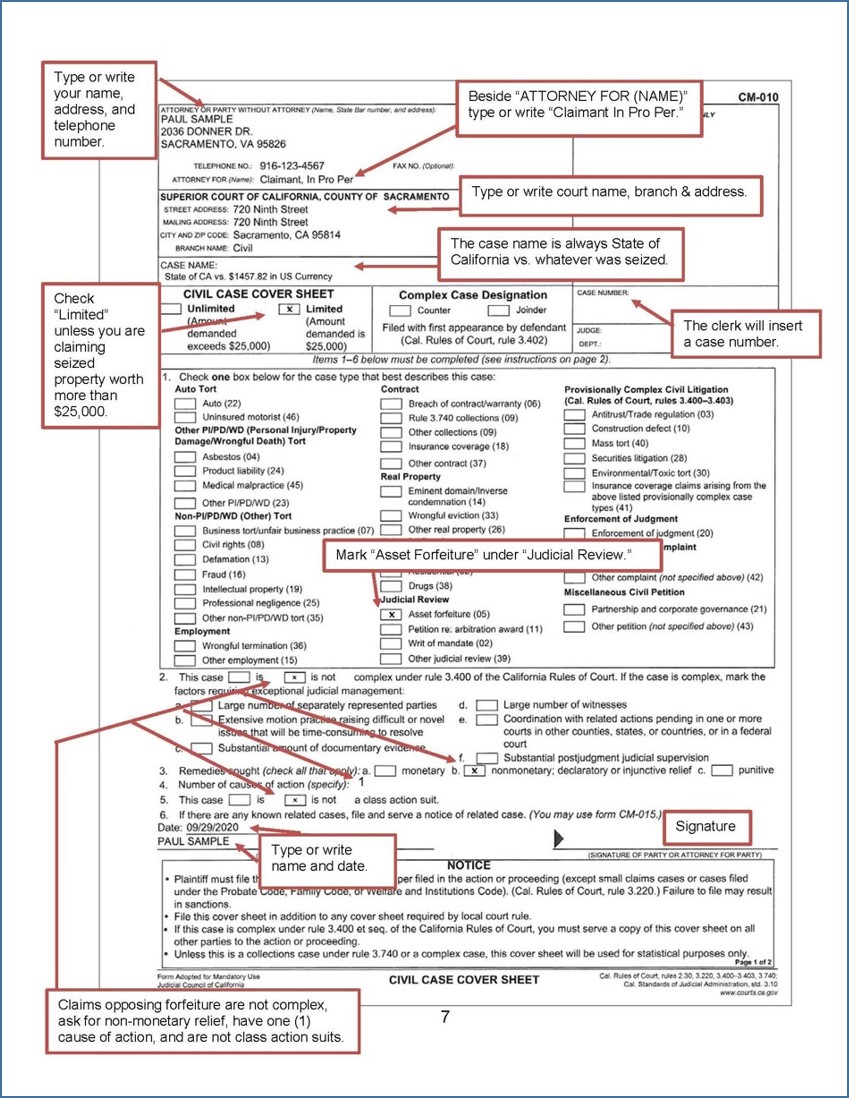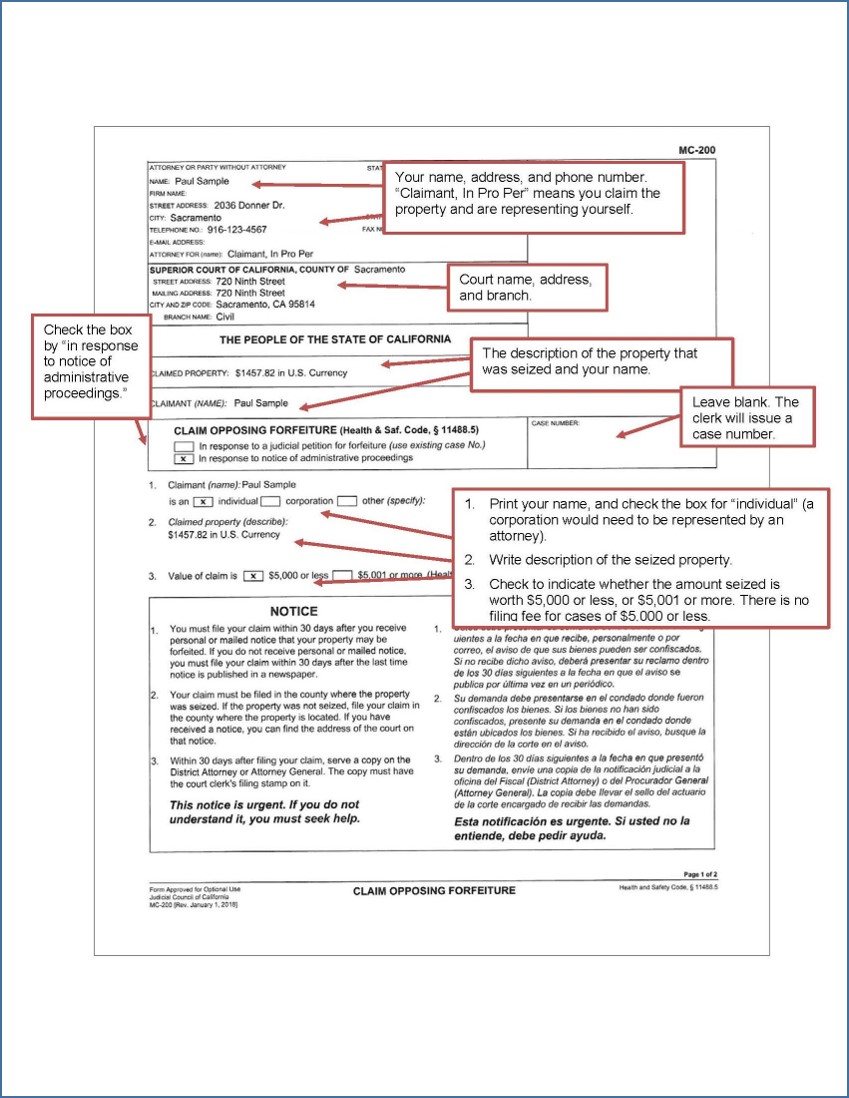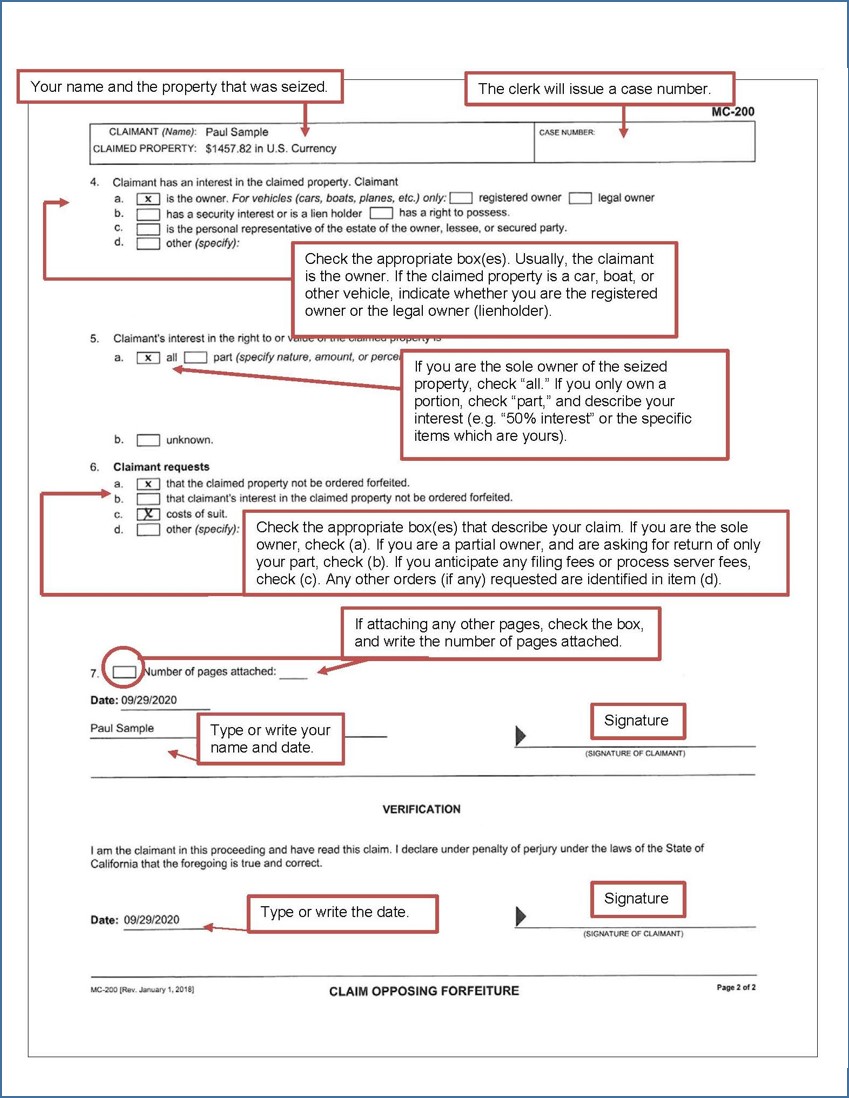Claim Opposing Forfeiture
The procedure described in this guide is used to ask for the return of property that may be forfeited as proceeds of criminal activity. If your property is the subject of forfeiture proceedings, you will be notified. In Sacramento County, if the property is taken at the time of arrest, law enforcement will provide the arrestee with the notice, usually a pink or yellow carbon copy. Otherwise, notice may be mailed to you from the District Attorney’s office.
Templates and Forms
IMPORTANT! This procedure is not used to ask for the return of property that was taken as evidence during an arrest or as part of a criminal case. The return of property taken in this way requires the use of different procedures. Talk to a lawyer or visit your local law library for more information if you are in that situation.
California Health and Safety Code §§ 11469-11495 allow local law enforcement agencies to seize property believed to be connected with controlled substances criminal activity. If the property is personal property worth $25,000 or less and no timely claims are filed, a prosecuting agency may, after notifying all potentially interested parties and publishing notice in a newspaper of general circulation in the county where the property was seized, issue a declaration of forfeiture without having to go to court. This is called an administrative (nonjudicial) forfeiture action.
If a Claim Opposing Forfeiture (MC-200) is timely filed and served, however, the prosecuting agency must file a petition for judicial forfeiture within 30 days after receipt of the claim. Otherwise, the prosecuting agency loses the right to maintain custody of the seized property.
You must file your Claim Opposing Forfeiture (MC-200) within 30 days after you receive personal or mailed notice that your property may be forfeited. If you do not receive personal or mailed notice, you must file your claim within 30 days after notice is first published in a newspaper.
Your Claim Opposing Forfeiture (MC-200) must be filed in the county where the property was seized. If you have received a notice, you can find the address of the court on that notice.
Within 30 days after filing your claim, you must serve a copy on the District Attorney. The copy you serve must have the court’s filing stamp on it.
Step by Step Instructions
1
Complete the Necessary Forms
The Judicial Council forms commonly used in this procedure are:
Sample filled-in forms with instructions are available at the end of this Guide.
2
Copying and Assembling
Make three copies of each:
- Claim Opposing Forfeiture (MC-200)
- Civil Case Cover Sheet (CM-010)
Staple each photocopy, but leave the originals unstapled.
For each document, place the original on top of its photocopies, and paperclip the stack together.
3
File Your Documents
File your documents at the Civil Filing Window in Room 100 of the Sacramento County Courthouse at 720 Ninth Street.
There is no filing fee if your claim is $5,000 or less. Claims above $5,000 require fees based on the amount of your claim. Current fees are available on the Sacramento County Superior Court’s website.
No fees will be collected at the time of filing if you also file a Request to Waive Court Fees. For more information, see our guide on Fee Waivers.
Provide the court with a self-addressed stamped envelope with sufficient postage to facilitate the return of your documents to you.
The court retains the original papers for its file, and will return the photocopies, stamped “Endorsed/ Filed,” to you.
4
Have Your Documents Served
You must serve a court-stamped, or endorsed, copy of your Claim Opposing Forfeiture packet on the District Attorney’s Office within 30 days of filing your Claim. You cannot serve the Claim packet yourself; you must have a person over the age of 18 who is not a party to your action do it for you.
Complete the Proof of Service by Mail (POS-030), but do not sign it. Make a copy of the unsigned form before proceeding. The server must then mail a copy of the Claim packet, along with a copy of the unsigned proof of service form, in an envelope addressed to: District Attorney, Asset Forfeiture Division, 901 G Street, Sacramento, CA 95814. The server then signs the Proof of Service by Mail (POS-030) and gives the signed form to you. For more information, see the Step-by-Step guide on Proof of Service by Mail on our website at saclaw.org/mail-service.
Alternatively, you may have someone over 18 who is not a party to the action personally serve the District Attorney’s office, by delivering the copies of the document to the acceptance window at 901 G Street, Sacramento, and completing a Proof of Personal Service (POS-020). For more information, see our guide on Personal Service.
5
Copy the Signed Proof of Service and File It
Make one copy of the signed proof of service, then file the original and photocopy in the drop box in Room 100 in the Sacramento Superior Court at 720 Ninth Street. Fill out and attach the Civil Document Drop-Off Sheet, and date stamp the back of the original proof of service. A supply of Civil Document Drop-Off Sheets and a date stamp are located near the drop box. There is no filing fee. Your stamped copy will be returned to you for your records.
6
What Happens Next? Discovery
After receiving your claim, the District Attorney files a Petition for Forfeiture to begin a judicial forfeiture action in court and starts pretrial discovery. You must watch the mail closely for any mail from the District Attorney. If you receive any paperwork, you must respond or you may risk losing your case. Your written responses must be in specific legal format, created using pleading paper, and all answers must be signed under penalty of perjury.
If you are served with discovery requests (such as “Request for Production of Documents” or “Requests for Admissions”), you only have 30 days to respond. If you fail to comply with discovery orders, the court may impose sanctions, deny your claim and award a judgment in favor of the DA.
The majority of these cases end when the claimant does not property respond to Requests for Admissions. Read our guide Responding to Requests for Admissions, which includes instructions and a template for your responses.
For help
SH@LL (Self-Help at the Law Library)
609 9th Street, Sacramento CA 95814
(916) 476-2731 (Appointment Request Line)
Services Provided: SH@LL provides general information and basic assistance to self-represented litigants on a variety of legal issues. All assistance is provided by telephone. Visit “What we can help with” for a list of qualifying cases.
Eligibility: Must be a Sacramento County resident or have a qualifying case in the Sacramento County Superior Court.
You must have a notice of forfeiture for assistance with a claim opposing forfeiture.
For More Information
At the Law Library:
California Criminal Law Procedure and Practice, KFC 1155 .C35
Chap. 57, Asset Forfeiture
California Criminal Law Forms Manual, KFC 1155 .A68 C34
Chap. 57, Asset Forfeiture
Samples
Civil Case Cover Sheet (CM-010)

Claim Opposing Forfeiture


This material is intended as general information only. Your case may have factors requiring different procedures or forms. The information and instructions are provided for use in the Sacramento County Superior Court. Please keep in mind that each court may have different requirements. If you need further assistance consult a lawyer.




